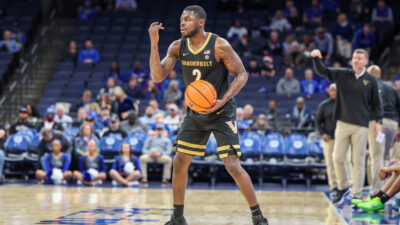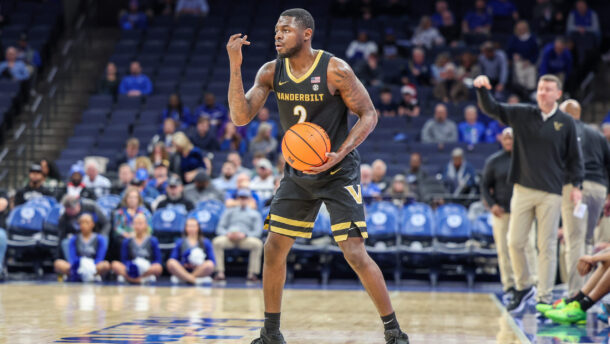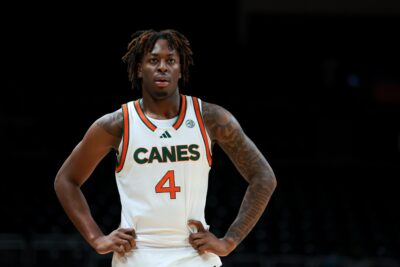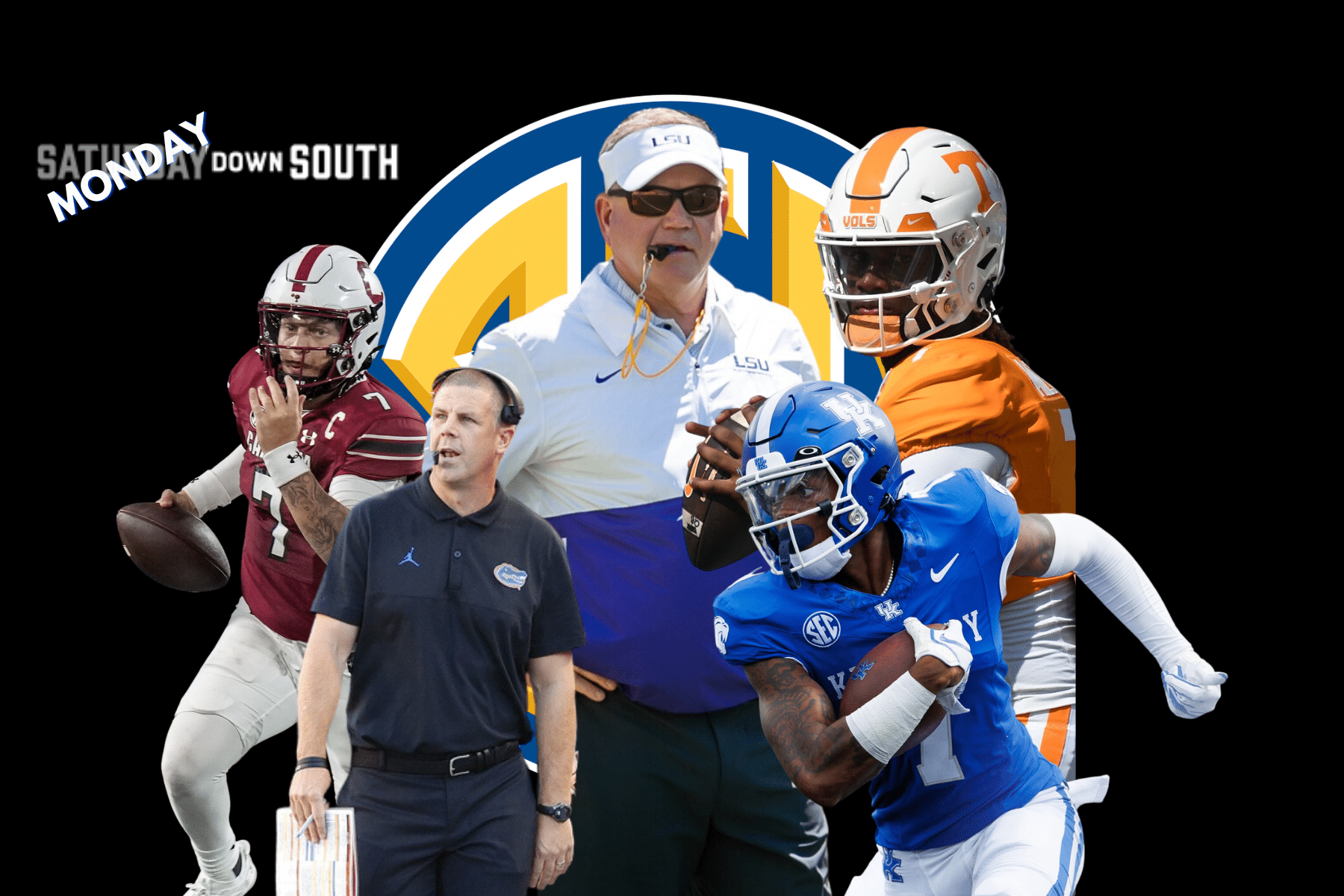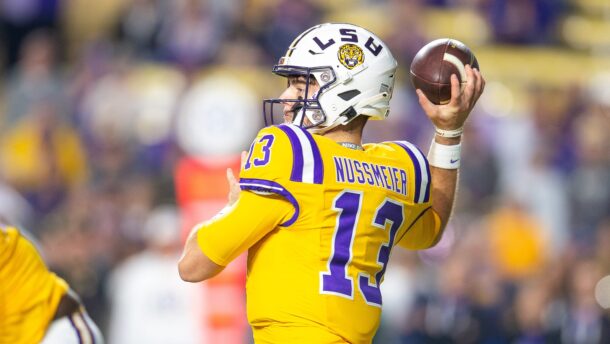
This offseason, I’ve been experimenting with a stat I’m calling dead-end throw rate.
Dead-end throw rate has a simple definition: How often do your passes result in an incomplete pass or a completion of 4 yards or fewer?
In short, it measures how wasteful a quarterback is on passing plays. It’s not perfect — it doesn’t account for rushing production or down-and-distance on a given play.
Why does it matter? I believe it can be used as a simplified tool for quarterback efficiency that strips away some of the noise that gets included in stats like traditional passer efficiency rating. Yardage, touchdowns and interceptions aren’t included at all in dead-end throw rate, but the metric still correlates at a high level with passer efficiency rating.
Dead-End Throw Rate for SEC quarterbacks
Here’s a breakdown of how (most) SEC quarterbacks performed in DETR last season:
Arkansas: Taylen Green
Green is an excellent example of why dead-end throw rate can be useful. From 2022 at Boise State to 2024 at Arkansas, Green saw his DETR improve from about 52% to roughly 42.5%. That’s a huge jump! And yet his passer efficiency rating only marginally improved from 137.2 to 138.2. Why? Because Green threw 3 more interceptions than he did in 2022 and had the same number of passing touchdowns.
But Green’s turnover-worthy play rate (per PFF) was 3.6% — a full point lower than his TWP rate at Boise State in 2022. By underlying metrics, Green was a drastically better passer in 2024 than he has been at any other point in his college career, but that isn’t apparent when looking at passer efficiency rating.
For Green, a 42.5% dead-end throw rate in 2024 puts him up in the upper-echelon of FBS quarterbacks. It ranks 18th out of 102 qualified (min. 240 pass attempts excluding non-CFP bowl games) quarterbacks for 2024. It also makes him the top returning SEC quarterback in terms of dead-end throw rate for 2025.
Auburn: Jackson Arnold
I wrote about Arnold’s dead-end throw rate earlier this offseason. In short: it wasn’t good at Oklahoma, as you might expect. Arnold posted a DETR of 56.1%. The FBS average (among qualifiers) last season was about 50.7%, so Arnold is well off pace.
There is some reason for optimism that Arnold could improve. For one, Oklahoma’s offensive structure and personnel were dreadful last season. Brent Venables made a mid-season OC change and Arnold’s top pass catchers were hurt all year.
Arnold is now stepping into a situation at Auburn where the Tigers are 21st nationally in offensive returning production, per ESPN’s Bill Connelly. That’s generally a pre-requisite for a big DETR spike after a poor season the year prior. But quarterbacks who are above the 55% DETR threshold in Year 1 often struggle to get below 50% following year. Since 2021, only Andrew Peasley (Wyoming, 2022-23) and Chevan Cordeiro (Hawaii and San Jose State, 2021-22) accomplished that.
One recent comp for Arnold could be Penn State’s Drew Allar, who went from a 52.3% DETR in 2023 to 45.7% in 2024. Allar also got a big offensive coordinator upgrade in his second season and, like Arnold, is a former blue-chip prospect out of high school with plenty of athletic tools.
Florida: DJ Lagway
In general, I’ve used 240 attempts as a cutoff for broader DETR analysis this offseason, which Lagway falls short of. But he’s close enough (192 attempts including the Gasparilla Bowl) to take a look at how Lagway performed by this metric in his freshman season.
Lagway had a DETR of just over 51% — roughly average nationally. I’d argue that’s a good result for a true freshman who was playing in a bit of a chaotic situation last year at Florida. The Gators faced a brutally-tough schedule and coach Billy Napier was on the hot seat, but Lagway still won enough games to keep Napier in Gainesville for another year.
Lagway has a very unique profile for a young quarterback — he’s pretty much always pushing the ball down field. Per PFF, he had an average depth of target of 11.8 yards last season which was among the power-conference leaders. PFF registered just 25 pass attempts that were behind the line of scrimmage. Lagway was also extremely successful on deep throws. He earned a big-time throw rate of 39.5% on passes that traveled at least 20+ yards in the air, which led all FBS quarterbacks last season (min. 35 attempts).
LSU: Garrett Nussmeier
Nussmeier is widely discussed as the top returning quarterback in the SEC (along with LaNorris Sellers). He posted a 49.7% DETR last season, which ranked just inside the top 40 among qualifiers. He trails Sellers and Green among returning SEC quarterbacks in this metric.
This is a good starting point for Nussmeier considering he threw an SEC-worst 12 interceptions last season. One thing we know about LSU is the Tigers are going to throw the ball — a lot. Nussmeier also led the SEC in completions and attempts last season. This figures to be a pass-heavy offense once again, so any uptick in efficiency could go a very long way for LSU.
LSU ranks 40th in offensive returning production and upgraded its wide receiver room significantly via the transfer portal this offseason. All the ingredients are there for Nussmeier to see a big DETR spike in 2025.
Mississippi State: Blake Shapen
Blake Shapen didn’t throw enough passes last season to qualify, but DETR has typically not been kind to him in his college career. At Baylor in 2023 and 2023, Shapen’s DETR was well below average (over 52% in both seasons). He was better last season, but only against a nonconference schedule that included Eastern Kentucky and Toledo. He was pretty good against Arizona State and then dreadful against Florida — his final game of the 2024 season.
There’s not much to work here in terms of recent data but I’m pretty pessimistic given his history at Baylor and the supporting cast he’ll have to work with at Mississippi State.
Oklahoma: John Mateer
Mateer is one of the more interesting names on this list. He was among the nation’s leaders in DETR last season at just under 45%, but that was against a very poor strength-of-schedule. He struggled in games against P4 opponents Texas Tech and Washington.
I wrote about Mateer more extensively earlier this offseason and found some reasons for optimism. Long story short, the recent track record for G5 quarterbacks moving up to the SEC level is pretty good. Mateer also benefits from keeping continuity together with offensive coordinator Ben Arbuckle. But there’s always going to be a level of doubt about a quarterback who relies on the running game as much as Mateer does (178 rush attempts last season) stepping into an SEC schedule — perhaps the most difficult one at that.
South Carolina: LaNorris Sellers
Sellers was named the preseason first-team All-SEC quarterback earlier this month, beating out the likes of Nussmeier, Arch Manning, Mateer and others. Sellers had an up-and-down season as a passer but was electric as a playmaker overall. But even with a few more inaccurate throws than you would have liked to see (particularly in the Alabama game), Sellers still posted a DETR just over 47%.
That’s above-average and is an excellent start point for Sellers, particularly as someone who is explosive on the ground as he is. Sellers also didn’t get a ton of help from his receiver corps last year, which should be improved in 2025. I do have some concerns with Mike Shula taking over as offensive coordinator, especially when so much was schemed open for Sellers last season on early downs.
Of the 42 power-conference quarterbacks last season who attempted at least 60 passes on 3rd and 5 or longer, Sellers was 37th in passer efficiency rating (106.8). The average among that sample of quarterbacks was 132.7. If he’s that bad of a passer on late downs again, South Carolina will have a capped ceiling.
Tennessee: Joey Aguilar
Jake Merklinger doesn’t have enough data, so even if he has some support to win this job out of fall camp, we can only analyze Joey Aguilar’s performance. Aguilar was dreadful from an efficiency standpoint in 2024 at Appalachian State. He ranked 91st out of 102 qualified quarterbacks with a DETR of 55.9%.
But there is reason for optimism with Aguilar. He was 29th in that metric in 2023 with the Mountaineers, but some of that may have been due to an inexperienced supporting cast. App State was 72nd in offensive returning production going into 2024, which is quite poor considering QB production is weighted heavily in ESPN’s returning production formula.
Aguilar is stepping into a better situation at Tennessee, albeit not a perfect one. There are questions about the Vols’ supporting cast, particularly at receiver and offensive line. But we saw Aguilar have a good season in 2023 and Tennessee does have a few talented playmakers, so there’s at least some basis for optimism heading into this fall in Knoxville.
Texas: Arch Manning
I’m pushing the bounds of sample size by including Manning here, but it’s worth taking a peek at what he was able to accomplish last season. Across just 90 pass attempts, Manning posted a dead-end throw rate of 46.7%. If Manning had stayed at that bar over a full season, he would have ranked in the top-25 nationally for 2024.
Of course, it’s worth noting that Manning’s schedule difficulty was quite poor for the majority of those reps. Sixty of his 90 pass attempts last season came against 2 teams: Louisiana-Monroe and Mississippi State. The rest of his production came in short spurts. Manning also wasn’t trusted enough to throw a single pass after Nov. 9 even as it became more clear that Quinn Ewers wasn’t at 100% health.
Texas A&M: Marcel Reed
Marcel Reed threw 240 pass attempts last season including Texas A&M’s bowl game, so he just barely missed my (admittedly-arbitrary) sample size cutoff. But that’s still a reasonable sample to analyze for the purposes of this piece. Reed posted a DETR of 50.8% last season, which is almost exactly average for all FBS qualifiers.
That’s a great starting place for a freshman quarterback who also brings quite a bit of value on the ground. The Aggies are also top-20 in offensive returning production for 2025, so there’s good reason to believe Reed will improve his DETR next season.
Vanderbilt: Diego Pavia
Diego Pavia had an up-and-down season last year. He lost to Georgia State but followed that up with a historic win over Alabama. At the end of the year, his DETR was slightly above average at 50.2%. Vanderbilt doesn’t throw the ball a lot, so it’s not going to be leaning on Pavia too much — at least on early downs.
But Pavia should be at least serviceable in 2025, especially as the Commodores rank in the top-10 in offensive returning production, per ESPN.
Who’s missing?
Some quarterbacks just don’t have enough data to include in this analysis. None of Alabama’s potential starters have over 100 career pass attempts, nor does Georgia’s Gunner Stockton. The same is true of Mizzou’s QB options in Beau Pribula and Sam Horn. Ole Miss quarterback Austin Simmons saw very little meaningful action outside of the Georgia game last season. Kentucky’s Zach Calzada hasn’t recorded an FBS pass attempt since 2021.
Dead-end throw rate history for (almost) every starting SEC QB in 2024
Here’s a look at the chart:
More context on dead-end throw rate
First, and perhaps most crucially, the stat correlates well with passer efficiency rating. That’s true despite DETR not having any context for touchdowns, interceptions, or yardage totals — things that weigh heavily on passer efficiency rating.
That’s a positive because sometimes the final outcome of a drive can be flukey and not necessarily representative of a quarterback’s success or failures. Maybe a QB led a great drive but the running back ran it in. Maybe a receiver ran the wrong route and an interception was thrown as a result. Maybe a key third-down pass was dropped or maybe a coach made a questionable fourth-down decision in the red zone.
Passing efficiency matters a great deal to winning football games. And if we can measure passing efficiency in a way that takes out some of the noisy elements of that metric, we could get a more accurate picture of quarterbacks who are consistently making winning plays.
Here’s a chart illustrating how dead-end throw rate correlates with passer efficiency rating since 2015:
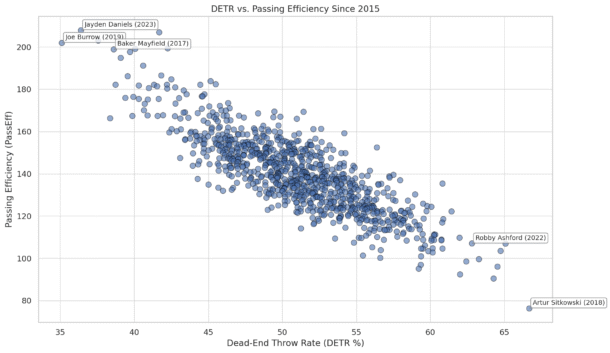
Top dead-end throw rates since 2015
Here’s a look at the top-10 single-season DETR performances since the beginning of the 2015 season:
Spenser is a news editor for Saturday Down South and covers college football across all Saturday Football brands.


